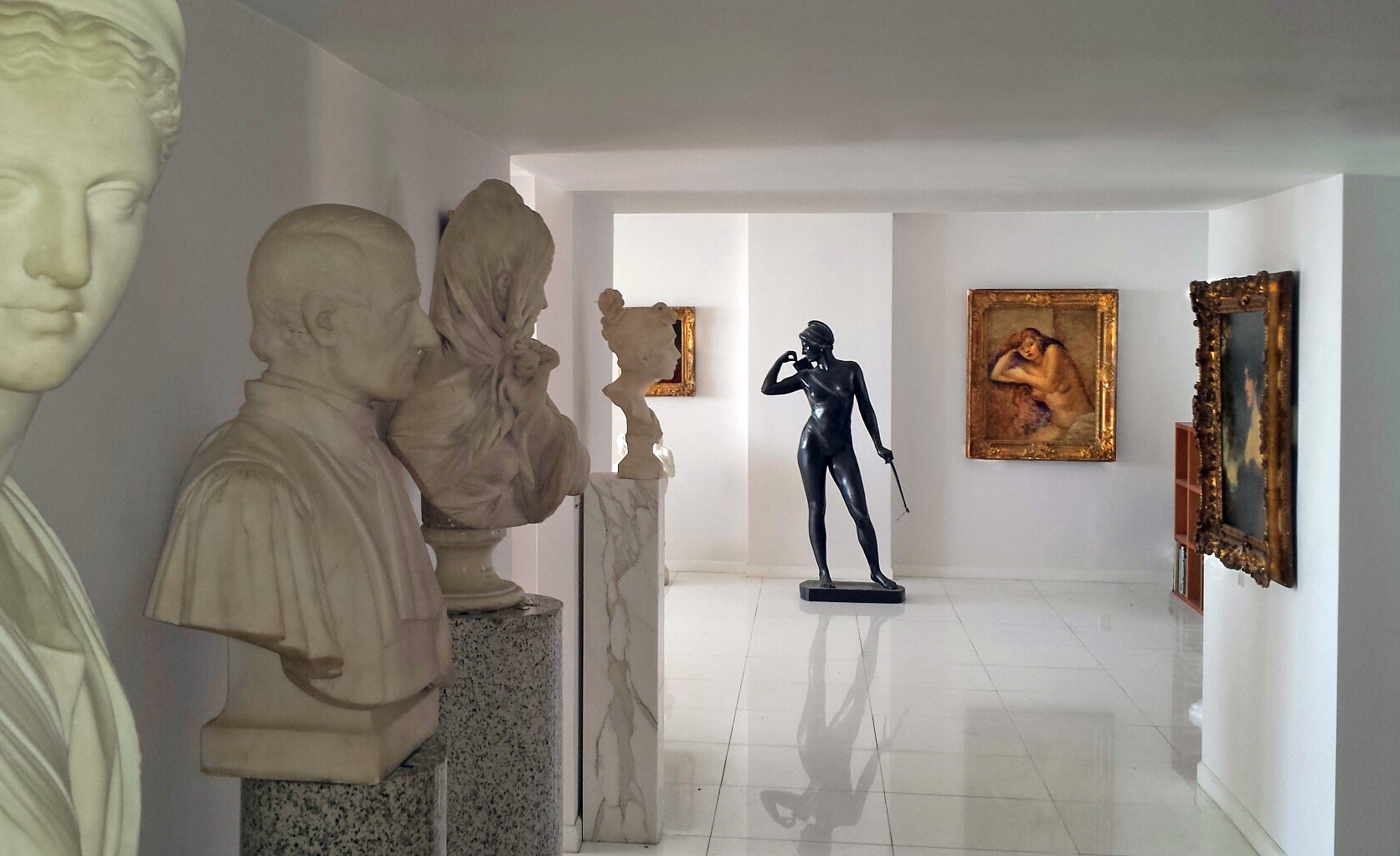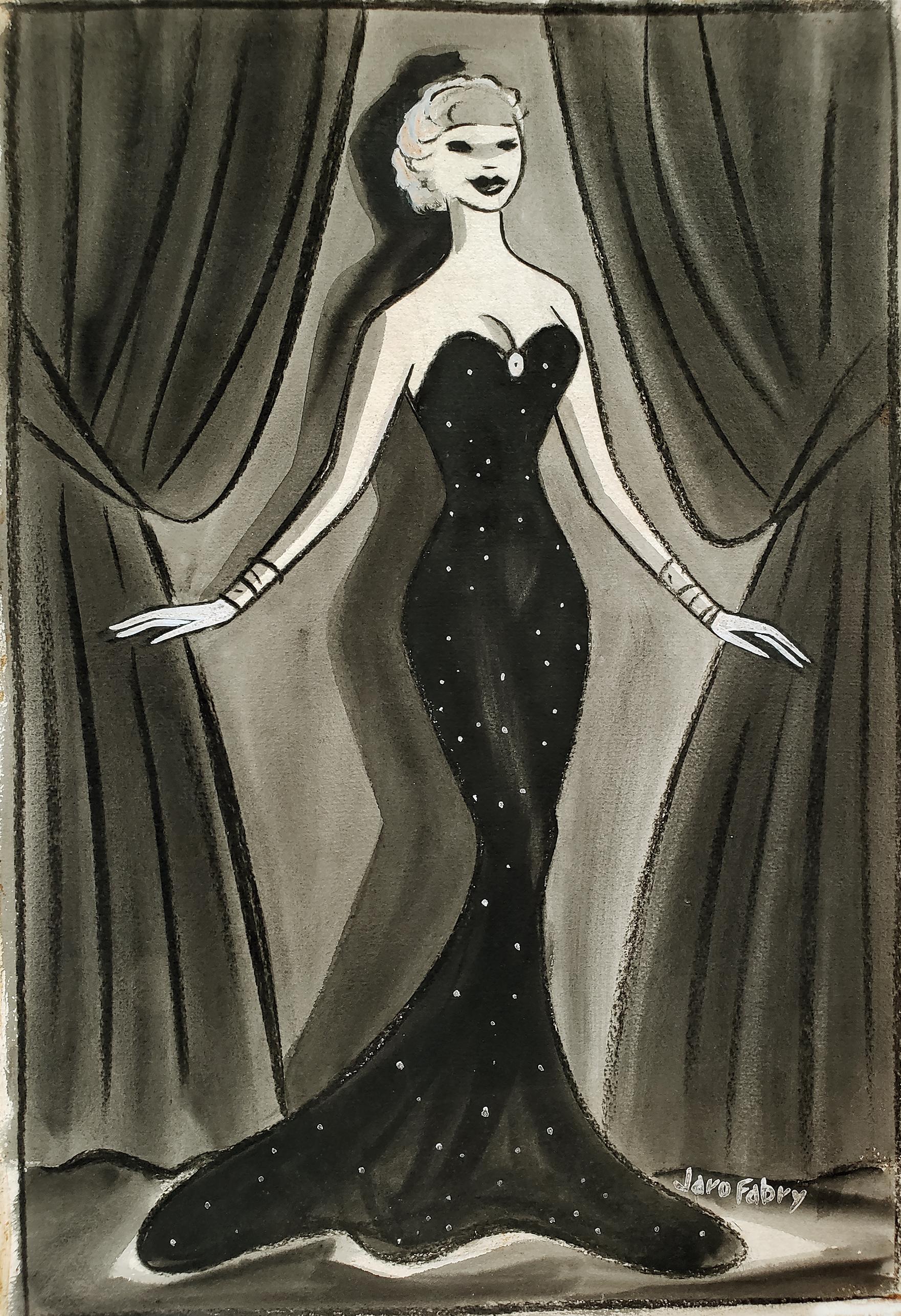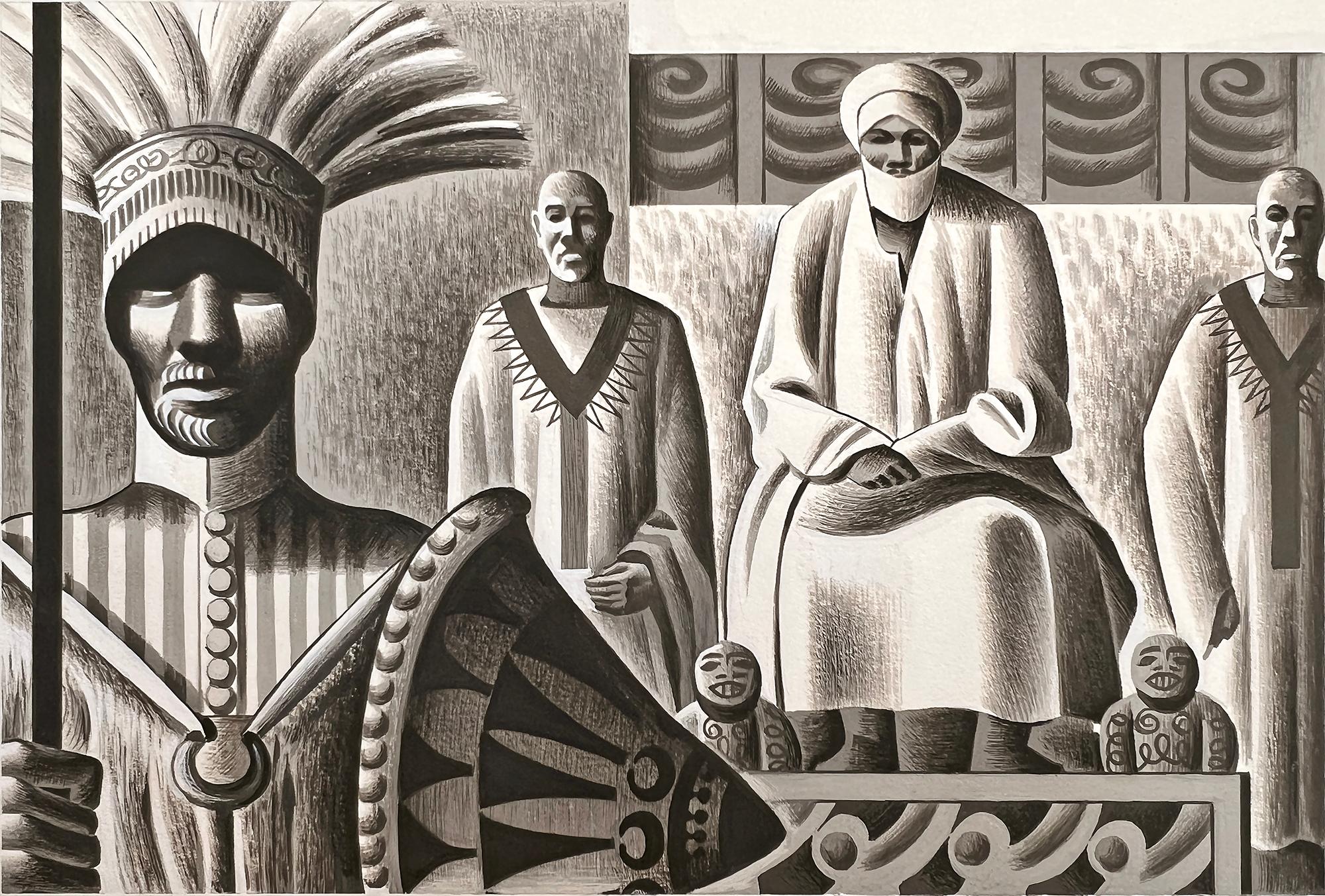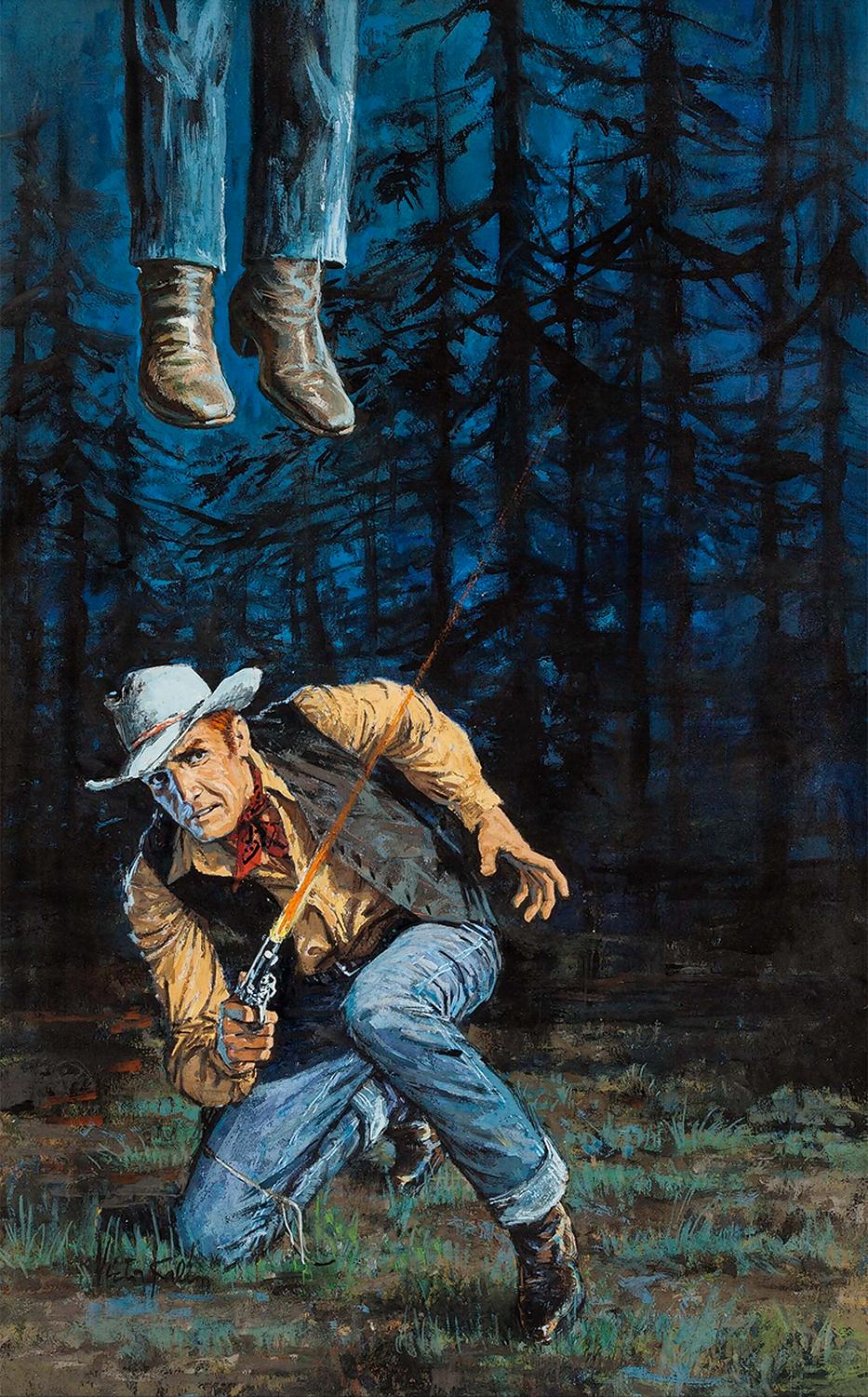Items Similar to Tales of the Arabian Nights with Flying Carpet - Random House Gustaf Tenggren
Want more images or videos?
Request additional images or videos from the seller
1 of 4
Tales of the Arabian Nights with Flying Carpet - Random House Gustaf Tenggren1957
1957
About the Item
Gustaf Tenggren- Attributed This masterfully designed and graphic interpretation of the Arabian Nights saga features a monumental figural profile while small figures float above on a magic carpet. Gustaf Tenggren (American 1896-1970) Attributed - We are not certain if Tenggren did this work. There is stylistic evidence to support Tenggren. It's the brilliance factor of how he assembles all the elements of the work and composes it into a cogent and readable form. This says Tenggen. As a former New York advertising agency art director, I have seen artists work in different styles. Usually this is not the case but great artist can do it. Their styles can change but the brilliance remains.
Untitled
Untitled
1957
Gouache on illustration board - Unframed
Not signed
9 x 7.25 live - 10.5 x 9.5 board
Original book illustration for Golden Tales of the Arabian Nights, page 19
"marked by the printer in pencil in lower margin on recto."
Provenance: Random House Archives
unframed
- Attributed to:Gustaf Tenggren (1896 - 1970, American)
- Creation Year:1957
- Dimensions:Height: 7.25 in (18.42 cm)Width: 9 in (22.86 cm)
- Medium:
- Movement & Style:
- Period:
- Condition:
- Gallery Location:Miami, FL
- Reference Number:1stDibs: LU38537478712

About the Seller
4.9
Gold Seller
These expertly vetted sellers are highly rated and consistently exceed customer expectations.
Established in 2005
1stDibs seller since 2016
102 sales on 1stDibs
Typical response time: 1 hour
- ShippingRetrieving quote...Ships From: Miami, FL
- Return PolicyA return for this item may be initiated within 3 days of delivery.
More From This SellerView All
- Glamorous Performer in Art Deco Black Evening Dress, Golden Age of HollywoodBy Jaro FabryLocated in Miami, FLwork is matted but not framed. Golden Age of Hollywood no illustrator chronicled the great stars, pin-ups and good girls better than Jaro Fabr...Category
1930s Art Deco Figurative Paintings
MaterialsWatercolor, Crayon, Gouache
- Fashion Illustration of Elegant woman in Bob Mackie dress perhaps for CherBy Michaele VollbrachtLocated in Miami, FLMost likely done for Cher. Gouache and watercolor on Arches paper. There is some minor undulation of the paper suface but only visible under raking light. Nicely framed and read...Category
1980s Art Deco Figurative Paintings
MaterialsWatercolor, Gouache
- Arabian Nights - Guard and Sitting King - Islamic Golden Age - Gustaf TenggrenBy Gustaf TenggrenLocated in Miami, FLOne Thousand and One Nights - It is often known in English as the Arabian Nights. What is notable about this work is how magnificently composed, designed, and rendered it is. Its l...Category
1950s Art Deco Figurative Paintings
MaterialsGouache
- Cowboy Hanging, Killer's Trail IllustrationBy Victor KalinLocated in Miami, FLThe old west depicted in a graphic and dramatic manner. Paperback Novel Cover Painting Original Art (Avon, 1963). Work has a matted image area of 12.5" ...Category
1960s American Realist Portrait Paintings
MaterialsGouache
- Soldier Beats Up Muggers on Subway - Stag Magazine story illustrationBy Mort KünstlerLocated in Miami, FLHand-signed by artist, sticker label, Signed (as Emmett Kaye) lower right it was Mort Kunstler's pseudonym, unframedCategory
1960s Realist Figurative Paintings
MaterialsGouache
- Girl at the Beach with wide Brim HatBy Bernie FuchsLocated in Miami, FLWonderful 60's chic is on full display in this beach scene. It's masterfully designed. The beautiful model horizontally fills the center space while supporting players fill background spaces. The style is very flat with lots of gray muting the colors and defining the artist's palette. Fuch's was a giant talent who is overlooked by today's art world participants. His style could be described as a post-post impressionist. This particular work is so deftly designed and exhibits the most intriguing positive and negative spaces. The model is rendered with loose, quick and authoritative brush strokes which give an air of chic confidence. Most of all, it's her dreamy blue eyes that truly captivate the viewer. All parts of the eye ( Iris, Pupil, Sclera ) are composed of a soft robin's egg blue which is in counterpoint the pink day-glow color on her lips. She looks at you. You look back and the process is repeated and repeated. Fuch's not just a great painter, designer, academic artist but a brilliant and innovative colorist as well. To demonstrate how great this simple work is, out of a world population of 7.2 billion people, as a betting man, I would say there may be no other artist who could render a scene this good. An artist such as Peter Doig, who does nice and beautiful work, may come close to the talent of Fuchs. Bernard Fuchs American, 1932 - 2009 Girl at the Beach...Category
1960s American Impressionist Figurative Paintings
MaterialsGouache
You May Also Like
- Vintage Mid-Century Modern Mini Swedish Figurative Portrait Painting - WhispersLocated in Bristol, GBWHISPERS Mixed Media on Board Size: 30 x 37 cm (including frame) A wonderfully expressive and brilliantly executed figurative composition in mixed media (oil, watercolour gouache), painted onto board. Two women in black headscarves are the focus of the scene, with very captivating expressions. The woman on the right appears to look almost shocked, with her mouth ajar and her eyes widened. The woman on the left stares directly at us, her emotion less identifiable. The scene is intriguing, making us question what these women have heard or what has happened. Their faces have been painted with brilliant detail, capturing the shadows on their faces as well as the aged skin of the woman on the right. These two women are set against a blue-ish green backdrop, making their faces stand out even more from within their black head scarves...Category
Mid-20th Century Modern Figurative Paintings
MaterialsOil, Board, Watercolor, Gouache
- A couple in sepia - Figurative Gouache Painting, Double Portrait, TexturedBy Agata StommaLocated in Warsaw, PLAGATA STOMMA She studied at the Academies of Fine Arts in Gda?sk and in Warsaw (1975-1981). After graduation she worked as an animator of animated films and made illustrations for bo...Category
21st Century and Contemporary Figurative Paintings
MaterialsCanvas, Gouache
- Two people - XXI Century, Figurative Gouache Painting,By Agata StommaLocated in Warsaw, PLPaintnig is on exhibition, please cuntact us for availability AGATA STOMMA She studied at the Academies of Fine Arts in Gda?sk and in Warsaw (1975-1981). After graduation she worked...Category
21st Century and Contemporary Contemporary Figurative Paintings
MaterialsCanvas, Gouache
- Outsider Folk Art Expressionist Rabbi Israeli Painting Signed Hebrew Jewish StarLocated in Surfside, FLThis is a signed portrait painting done in an outsider, folk art, expressionist style. it is signed in Hebrew, also marked with a Jewish star. this is from a collection of works by the same hand. they are all signed. Some have markings to the back of the paper. they have some age to them. They bear similarities to artists as dissimilar as Moshe tamir, Mane Katz and an Israeli version of Purvis Young. In this piece the artist choice of colors is muted yet powerful. Israel has had a Vibrant Folk Art, Naive art scene for a long time now, artists like Yisrael Paldi, Nahum Guttman, Reuven Rubin and even Yefim Ladyzhensky had naive periods. The most well know of the strict naive artists are Shalom of Safed, Irene Awret, Gabriel Cohen, Natan Heber, Michael Falk and Kopel Gurwin. Naïve art is any form of visual art that is created by a person who lacks the formal education and training that a professional artist undergoes (in anatomy, art history, technique, perspective, ways of seeing). Unlike folk art, naïve art does not necessarily evince a distinct cultural context or tradition. Naïve art is recognized, and often imitated, for its childlike simplicity and frankness. Paintings of this kind typically have a flat rendering style with a rudimentary expression of perspective. One particularly influential painter of "naïve art" was Henri Rousseau (1844–1910), a French Post-Impressionist who was discovered by Pablo Picasso. Naïve art is often seen as outsider art that is by someone without formal (or little) training or degree. While this was true before the twentieth century, there are now academies for naïve art. Naïve art is now a fully recognized art genre, represented in art galleries worldwide. Museums devoted to naïve art now exist in Kecskemét, Hungary; Riga, Latvia; Jaen, Spain; Rio de Janeiro, Brasil; Vicq France and Paris. "Primitive art" is another term often applied to art by those without formal training, but is historically more often applied to work from certain cultures that have been judged socially or technologically "primitive" by Western academia, such as Native American, sub saharan African or Pacific Island art (see Tribal art). This is distinguished from the self-conscious, "primitive" inspired movement primitivism. Another term related to (but not completely synonymous with) naïve art is folk art. There also exist the terms "naïvism" and "primitivism" which are usually applied to professional painters working in the style of naïve art (like Paul Gauguin, Mikhail Larionov, Paul Klee). At all events, naive art can be regarded as having occupied an "official" position in the annals of twentieth-century art since - at the very latest - the publication of the Der Blaue Reiter, an almanac in 1912. Wassily Kandinsky and Franz Marc, who brought out the almanac, presented 6 reproductions of paintings by le Douanier' Rousseau (Henri Rousseau), comparing them with other pictorial examples. However, most experts agree that the year that naive art was "discovered" was 1885, when the painter Paul Signac became aware of the talents of Henri Rousseau and set about organizing exhibitions of his work in a number of prestigious galleries. The Earth Group (Grupa Zemlja) were Croatian artists, architects and intellectuals active in Zagreb from 1929 to 1935. The group included the painters Krsto Hegedušić, Edo Kovačević, Omer Mujadžić, Kamilo Ružička, Ivan Tabaković, and Oton Postružnik, the sculptors Antun Augustinčić, Frano Kršinić, and the architect Drago Ibler. Art brut, primitive art, primitive, art naïf, naïve art. Outsider art. A term applied to Yugoslav (Croatian) naive painters working in or around the village of Hlebine, near the Hungarian border, from about 1930. Some of the best known naive artists are Dragan Gaži, Ivan Generalić, Josip Generalić, Krsto Hegedušić, Mijo Kovačić, Ivan Lacković-Croata, Franjo Mraz, Ivan Večenaj and Mirko Virius. Camille Bombois (1883–1970) Ferdinand Cheval, known as 'le facteur Cheval' (1836–1924) Henry Darger (1892–1973) L. S. Lowry (1887–1976) Grandma Moses, Anna Mary Robertson (1860–1961) Nikifor (1895–1968) Poland, Horace Pippin (1888–1946) Jon Serl (1894-1993) United States Alfred Wallis (1855–1942) Scottie Wilson (1890–1972) Gesner Abelard (b. 1922) Jan Balet (1913–2009) Michel Delacroix (b. 1933) France Howard Finster (1916–2001) Ivan Rabuzin (1921–2008) Spontaneous Art Museum in Brussels Art en Marge Museum in Brussels MADmusée in Liege International Museum of Naive Art of Brazil in Cosme Velho, Rio de Janeiro Gallery Jacques Ardies in São Paulo Musée international d'art naïf de Magog in Magog Croatian Museum of Naïve Art in Zagreb Gallery of Croatian Naïve Art...Category
20th Century Outsider Art Portrait Paintings
MaterialsGouache
- Outsider Folk Art Expressionist Rabbi Israeli Painting Signed Hebrew Jewish StarLocated in Surfside, FLThis is a signed portrait painting done in an outsider, folk art, expressionist style. This one looks like a Chassidic Breslov Hasidic man. it is signed in Hebrew, also marked with a Jewish star. this is from a collection of works by the same hand. they are all signed. Some have markings to the back of the paper. they have some age to them. They bear similarities to artists as dissimilar as Moshe Tamir, Mane Katz and an Israeli version of Purvis Young. In this piece the artist choice of colors is muted yet powerful. Israel has had a Vibrant Folk Art, Naive art scene for a long time now, artists like Yisrael Paldi, Nahum Guttman, Reuven Rubin and even Yefim Ladyzhensky...Category
20th Century Outsider Art Portrait Paintings
MaterialsGouache
- Outsider Folk Art Expressionist Rabbi Israeli Painting Signed Hebrew Jewish StarLocated in Surfside, FLThis is a signed portrait painting done in an outsider, folk art, expressionist style. it is signed in Hebrew, also marked with a Jewish star. this is from a collection of works by the same hand. they are all signed. Some have markings to the back of the paper. they have some age to them. They bear similarities to artists as dissimilar as Moshe Tamir, Mane Katz and an Israeli version of Purvis Young. In this piece the artist choice of colors is muted yet powerful. Israel has had a Vibrant Folk Art, Naive art scene for a long time now, artists like Yisrael Paldi, Nahum Guttman, Reuven Rubin and even Yefim Ladyzhensky had naive periods. The most well know of the strict naive artists are Shalom of Safed, Irene Awret, Gabriel Cohen, Natan Heber, Michael Falk and Kopel Gurwin. Naïve art is any form of visual art that is created by a person who lacks the formal education and training that a professional artist undergoes (in anatomy, art history, technique, perspective, ways of seeing). Unlike folk art, naïve art does not necessarily evince a distinct cultural context or tradition. Naïve art is recognized, and often imitated, for its childlike simplicity and frankness. Paintings of this kind typically have a flat rendering style with a rudimentary expression of perspective. One particularly influential painter of "naïve art" was Henri Rousseau (1844–1910), a French Post-Impressionist who was discovered by Pablo Picasso. Naïve art is often seen as outsider art that is by someone without formal (or little) training or degree. While this was true before the twentieth century, there are now academies for naïve art. Naïve art is now a fully recognized art genre, represented in art galleries worldwide. Museums devoted to naïve art now exist in Kecskemét, Hungary; Riga, Latvia; Jaen, Spain; Rio de Janeiro, Brasil; Vicq France and Paris. "Primitive art" is another term often applied to art by those without formal training, but is historically more often applied to work from certain cultures that have been judged socially or technologically "primitive" by Western academia, such as Native American, sub saharan African or Pacific Island art (see Tribal art). This is distinguished from the self-conscious, "primitive" inspired movement primitivism. Another term related to (but not completely synonymous with) naïve art is folk art. There also exist the terms "naïvism" and "primitivism" which are usually applied to professional painters working in the style of naïve art (like Paul Gauguin, Mikhail Larionov, Paul Klee). At all events, naive art can be regarded as having occupied an "official" position in the annals of twentieth-century art since - at the very latest - the publication of the Der Blaue Reiter, an almanac in 1912. Wassily Kandinsky and Franz Marc, who brought out the almanac, presented 6 reproductions of paintings by le Douanier' Rousseau (Henri Rousseau), comparing them with other pictorial examples. However, most experts agree that the year that naive art was "discovered" was 1885, when the painter Paul Signac became aware of the talents of Henri Rousseau and set about organizing exhibitions of his work in a number of prestigious galleries. The Earth Group (Grupa Zemlja) were Croatian artists, architects and intellectuals active in Zagreb from 1929 to 1935. The group included the painters Krsto Hegedušić, Edo Kovačević, Omer Mujadžić, Kamilo Ružička, Ivan Tabaković, and Oton Postružnik, the sculptors Antun Augustinčić, Frano Kršinić, and the architect Drago Ibler. Art brut, primitive art, primitive, art naïf, naïve art. Outsider art. A term applied to Yugoslav (Croatian) naive painters working in or around the village of Hlebine, near the Hungarian border, from about 1930. Some of the best known naive artists are Dragan Gaži, Ivan Generalić, Josip Generalić, Krsto Hegedušić, Mijo Kovačić, Ivan Lacković-Croata, Franjo Mraz, Ivan Večenaj and Mirko Virius. Camille Bombois (1883–1970) Ferdinand Cheval, known as 'le facteur Cheval' (1836–1924) Henry Darger (1892–1973) L. S. Lowry (1887–1976) Grandma Moses, Anna Mary Robertson (1860–1961) Nikifor (1895–1968) Poland, Horace Pippin (1888–1946) Jon Serl (1894-1993) United States Alfred Wallis (1855–1942) Scottie Wilson (1890–1972) Gesner Abelard (b. 1922) Jan Balet (1913–2009) Michel Delacroix (b. 1933) France Howard Finster (1916–2001) Ivan Rabuzin (1921–2008) Spontaneous Art Museum in Brussels Art en Marge Museum in Brussels MADmusée in Liege International Museum of Naive Art of Brazil in Cosme Velho, Rio de Janeiro Gallery Jacques Ardies in São Paulo Musée international d'art naïf de Magog in Magog Croatian Museum of Naïve Art in Zagreb Gallery of Croatian Naïve Art...Category
20th Century Outsider Art Portrait Paintings
MaterialsGouache
Recently Viewed
View AllMore Ways To Browse
Deco House
Vintage Book Illustrations
The Art Of Flying
Original Book Illustration
House Of Brilliance
Magic Carpet
Flying House
Vintage Flying A Sign
Art Deco Flying
Art Deco Book Cases
Arabian Nights
The Arabian Nights
Arabia 1970
Flying Golden
Arabian Carpets
Arabian Nights Vintage
Art Deco Advertising Figure
Arabian Nights Vintage Book





